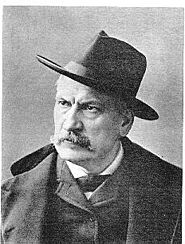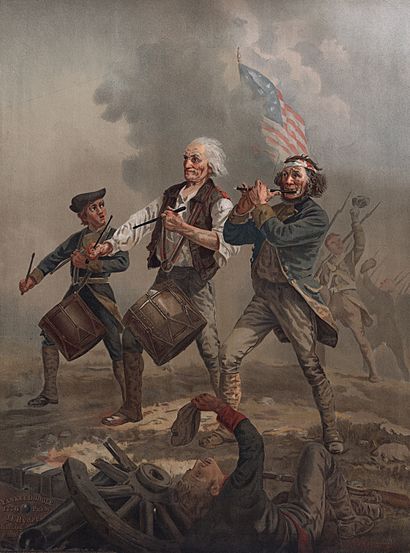Archibald Willard facts for kids
Quick facts for kids
Archibald Willard
|
|
|---|---|
 |
|
| Born |
Archibald MacNeal Willard
August 22, 1836 Bedford, Ohio, U.S.
|
| Died | October 11, 1918 (aged 82) U.S.
|
| Known for | Painting |
|
Notable work
|
The Spirit of '76 (c. 1875) |
Archibald MacNeal Willard (born August 22, 1836 – died October 11, 1918) was an American painter. He was born and grew up in Bedford, Ohio. His father, Samuel Willard, was a pastor at the Bedford Baptist Church.
Archibald Willard's Artistic Journey
Archibald loved art from a young age. He would often draw on barns and other buildings around his home. When he was older, Willard moved to Wellington, Ohio. There, he started working for a wagon maker named E.S. Tripp.
At first, Willard just painted wagons. But soon, he was allowed to add fancy decorations that were popular back then. In 1863, Willard joined the 86th Ohio Infantry Regiment. He served in the Civil War, but he wasn't in a lot of heavy fighting. During this time, he painted several scenes from the war.
After the war, Willard created two paintings for Tripp's daughter, Addie. They were called Pluck and Pluck No. 2. In Pluck, three children ride in a cart pulled by a dog chasing a rabbit. In Pluck No. 2, the cart has crashed because they were going too fast.
These paintings helped him connect with a photographer named James F. Ryder. Ryder made money by using a printing method called chromolithography. This allowed him to print popular pictures for homes. Ryder thought Willard could create funny and cheerful paintings that would sell well.
Willard also painted three large pictures for the main hall of the Fayette County courthouse in Washington Court House, Ohio. These were called The Spirit of Electricity, The Spirit of Telegraphy, and The Spirit of the Mail.
Archibald Willard is buried in Wellington, Ohio, at the Greenwood Cemetery. A street in his hometown, Bedford, is named Willard Avenue after him. There is also a Willard Drive in nearby Garfield Heights.
The Spirit of '76: Willard's Famous Painting
| The Spirit of '76 (aka Yankee Doodle) | |
|---|---|
 |
|
| Artist | Archibald Willard |
| Year | c. 1875 |
| Type | oil |
| Dimensions | 61 cm × 45 cm (24 in × 18 in) |
| Location | Abbot Hall in Marblehead, Massachusetts |
Willard's most famous painting is The Spirit of '76. It was also known as Yankee Doodle. He painted it around 1875 in Wellington, Ohio. He got the idea after seeing a holiday parade pass through the town square.
The painting was shown at the Centennial Exposition in Philadelphia, Pennsylvania in 1876. Some stories say people loved it right away. They even say President Grant praised it. But this isn't quite true. The painting wasn't very popular at first. It was placed in a separate art area because there were so many other artworks. It also wasn't advertised much. Art critics didn't like it either; one even called it "oppressive."
The painting became famous mostly because of Ryder's smart marketing. He sold printed copies (chromolithographs) of the painting. They cost five dollars each at first, and then less as the exhibition went on. After the exhibition, the painting became popular enough to travel across the country. Large crowds came to see it.
The original The Spirit of '76 painting is now displayed at Abbot Hall in Marblehead, Massachusetts. Willard also painted several other versions of the painting later. These have been shown in different places, including the United States Department of State.
Willard first drew a sketch for the painting. It showed three men dancing and singing. He used his own father, Samuel Willard, as the model for the middle character. Hugh Mosher was the model for the fifer (the person playing the fife). The young boy in the painting was Henry Devereaux. Including his father made this painting different from Willard's usual funny style. He felt a special connection to his father's work as a minister and his grandfather's part in the Revolutionary War.
Willard also created other artworks, like The Blue Girl. After The Spirit of '76 became famous, he saw himself as a very important artist. But his later works didn't get much attention or make him a lot of money. They often looked like The Spirit of '76 or told U.S. history stories in a simple, folksy way. His fame as an artist only returned briefly in 1895. This was when The Spirit of '76 and possibly another of his works were used in advertisements for the Spanish–American War.
The Spirit of '76 in Pop Culture
The Spirit of '76 painting has appeared in many other forms of media:
- The cover of the July 1939 issue of Mickey Mouse Magazine showed a funny version of the painting. Mickey Mouse, Donald Duck, and Goofy were in place of the soldiers. Disney later used this art in 1975 for the logo of America on Parade at Disneyland and Walt Disney World. It also inspired the design of the first float in that parade.
- The end scene of the 1950 Merrie Melodies cartoon Bunker Hill Bunny makes fun of the painting. It stars Bugs Bunny and Yosemite Sam.
- On the 1961 comedy album Stan Freberg Presents the United States of America Volume One: The Early Years, a song called "Yankee Doodle Go Home (Spirit of '76)" features the younger musicians complaining about the older drummer's old-fashioned playing.
- In the 1963 World War II movie The Great Escape, two characters, Hilts and Hendley, celebrate the 4th of July in a Nazi German POW camp. They wake up the camp by playing "Yankee Doodle." They are dressed like the characters in the painting.
- The writer Kurt Vonnegut mentioned the painting in his 1969 novel Slaughterhouse-Five. In one part, the main character, Billy Pilgrim, walks through a POW camp. Billy is described as looking like a funny version of The Spirit of '76.
- On January 1, 1976, the U.S. Postal Service released three commemorative stamps based on the painting. This was part of the Bicentennial celebration. These three connected stamps, called Spirit of '76, were sold in sheets of fifty. They cost 13 cents, which was the price to mail a letter back then.
- The New York hardcore band Warzone used the painting for the cover of their 1996 album The Sound of Revolution.

